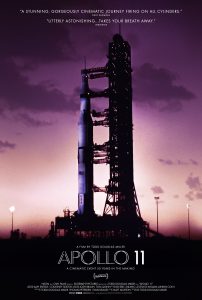By David E. Hubler
Contributor, InSpace News
For those old enough to remember watching the first moon landing live on an old black and white TV in 1969 and wishing you could see the historic show in color, your wish has now come true. And, believe me, the 50-year wait for “Apollo 11” was worth it.

This 93-minute IMAX documentary from Neon Films and CNN is notable for the absence of a narrator. The final preparations for launch are voiced by veteran CBS News anchor Walter Cronkite. Once known as the most trusted man in America, Cronkite was “the nation’s narrator.” Taken from recordings of his live coverage of the Apollo 11 mission, Cronkite’s perfectly paced intonation sets the scene of the final flight preparations.
Kudos to director Todd Douglas Miller. He had the Herculean task of poring through a newly discovered trove of 65mm film footage and more than 11,000 hours of uncatalogued audio recordings to create a film of awesome beauty and unmatched clarity. Miller’s effort is a worthy tribute to what clearly ranks among the greatest human feats since Columbus steered three tiny vessels across the largely unknown Atlantic Ocean.
NASA Engineers in Cape Canaveral and Houston Monitored the Apollo 11 Flight
The film takes us into NASA’s manned space centers at Cape Canaveral, Florida, and Houston, Texas. There, row upon row of seated engineers — all identically clad in short-sleeved white shirts and narrow dark ties — stare intently at early-model computer screens monitoring every aspect of the flight.
As the trio of astronauts — Neil Armstrong, Edwin “Buzz” Aldrin, and Michael Collins — move into the vehicle that will transport them to the launch pad, we also see a couple of technicians wedged into the bowels of the Saturn 5 rocket fixing a small leak.
Meanwhile, mission control continues the staccato countdown to liftoff with all the emotion of the atomic clock calling out the minutes and seconds of the current hour.
Thanks to some of the recently found footage, we ride with the astronauts to their capsule high atop the Saturn 5 for an awesome view of Florida’s east coast. On the ground, thousands of spectators are camped out for miles around Cape Canaveral to watch the historic launch. We are in the midst of perhaps the largest-ever tailgating party.
Then the massive engines roar into a screen-filling, ear-piercing conflagration of flames and smoke that explodes across the massive IMAX screen. And we’re off, virtually in the capsule with the astronauts.
Possible spoiler alert: The flight of Apollo 11 goes without a hitch. There is no “Houston, we have a problem,” as occurred in the 1970 flight of Apollo 13, which became the watchword of the 1995 Tom Hanks’ film of that name.
No dramatic device is needed in this true-life adventure. The clarity and breadth of the moonscape as the Lunar Module Eagle slowly descends to the surface of the moon is drama enough.
The Eagle’s historic touchdown, within a couple of miles of NASA’s preselected spot, is worth the price of admission alone. Thanks to IMAX and a Hasselblad lunar surface camera, we are with Armstrong as he descends the ladder to the surface, becoming the first human to set foot on our only moon. We all know what comes next: “One small step for man, one giant leap for mankind….”
Armstrong and Aldrin’s two hour, 40-minute walk on the moon is compressed into a few magical minutes on screen. I wish it could have lasted longer.
Rendezvous between Columbia and Eagle Was a Major Engineering Feat
Their successful rendezvous with Collins, circling the moon in the Command Module Columbia, is a major engineering feat in itself: Two tiny space vehicles maneuvering toward each other for three and a half hours and nearly two orbits of the moon before successfully linking up.
The splashdown in the Pacific Ocean and recovery by the USS Hornet brings an audible sigh of relief from the audience even now, four months prior to the 50th anniversary of that landing.
The first manned landing on the moon was a picture-perfect effort and the IMAX film proves it, as they say, in living color.
A giant screen, 40-minute version of the movie, “Apollo 11: First Steps,” will be released in the coming months. It is not a cut-down version of Apollo 11; it includes footage not shown in the IMAX version.
Someday, people on this planet — and perhaps on others as well — will watch Miller’s film and may find it amusing, just as we have viewed film of the Wright brothers’ first flight. “How primitive those NASA scientists and their technology were — making such a routine task as sending three men to the moon so complex!”
But until that day comes, you’ve got to be impressed by seeing those first bootprints in the lunar soil.

Comments are closed.